The Sandy Bridge Review: Intel Core i7-2600K, i5-2500K and Core i3-2100 Tested
by Anand Lal Shimpi on January 3, 2011 12:01 AM ESTGaming Performance
There's simply no better gaming CPU on the market today than Sandy Bridge. The Core i5 2500K and 2600K top the charts regardless of game. If you're building a new gaming box, you'll want a SNB in it.
Our Fallout 3 test is a quick FRAPS runthrough near the beginning of the game. We're running with a GeForce GTX 280 at 1680 x 1050 and medium quality defaults. There's no AA/AF enabled.
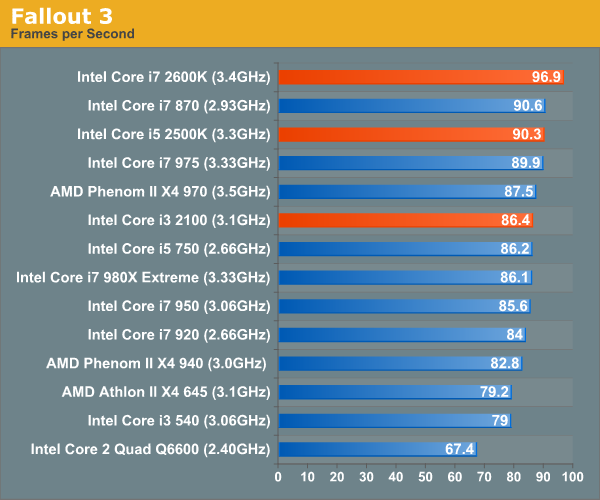
In testing Left 4 Dead we use a custom recorded timedemo. We run on a GeForce GTX 280 at 1680 x 1050 with all quality options set to high. No AA/AF enabled.

Far Cry 2 ships with several built in benchmarks. For this test we use the Playback (Action) demo at 1680 x 1050 in DX9 mode on a GTX 280. The game is set to medium defaults with performance options set to high.
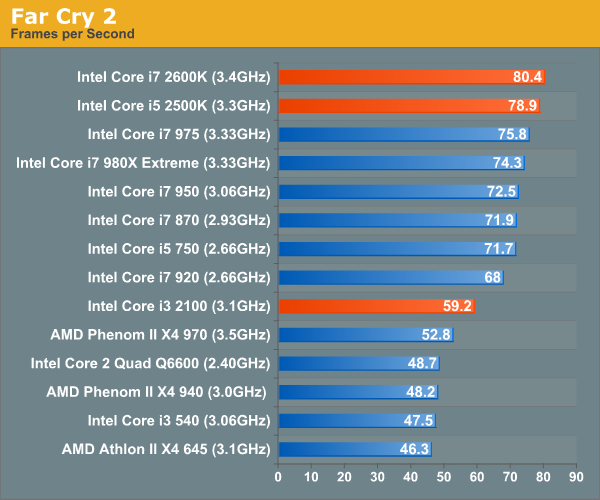
Crysis Warhead also ships with a number of built in benchmarks. Running on a GTX 280 at 1680 x 1050 we run the ambush timedemo with mainstream quality settings. Physics is set to enthusiast however to further stress the CPU.
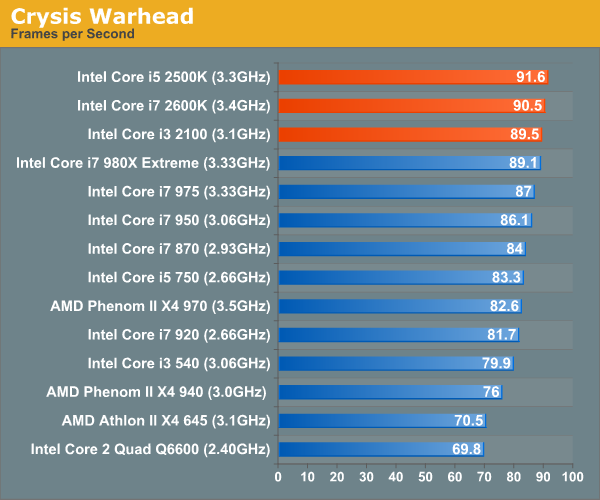
Our Dragon Age: Origins benchmark begins with a shift to the Radeon HD 5870. From this point on these games are run under our Bench refresh testbed under Windows 7 x64. Our benchmark here is the same thing we ran in our integrated graphics tests - a quick FRAPS walkthrough inside a castle. The game is run at 1680 x 1050 at high quality and texture options.
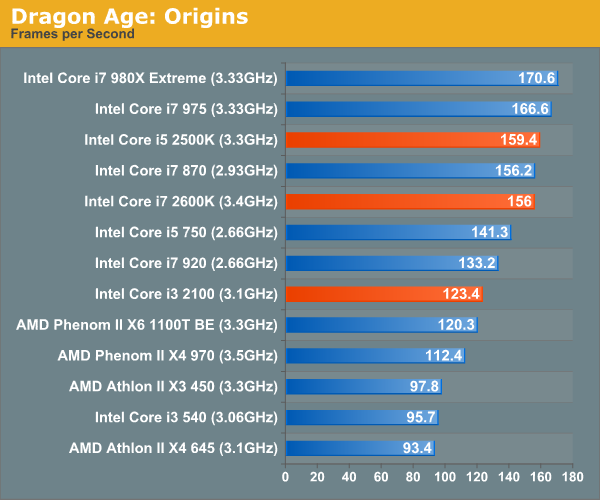
We're running Dawn of War II's internal benchmark at high quality defaults. Our GPU of choice is a Radeon HD 5870 running at 1680 x 1050.
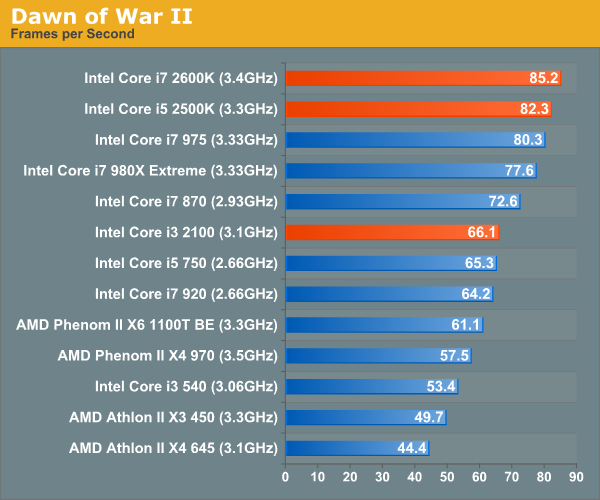
Our World of Warcraft benchmark is a manual FRAPS runthrough of a lightly populated server with no other player controlled characters around. The frame rates here are higher than you'd see in a real world scenario, but the relative comparison between CPUs is accurate.
We run on a Radeon HD 5870 at 1680 x 1050. We're using WoW's high quality defaults but with weather intensity turned down all the way.
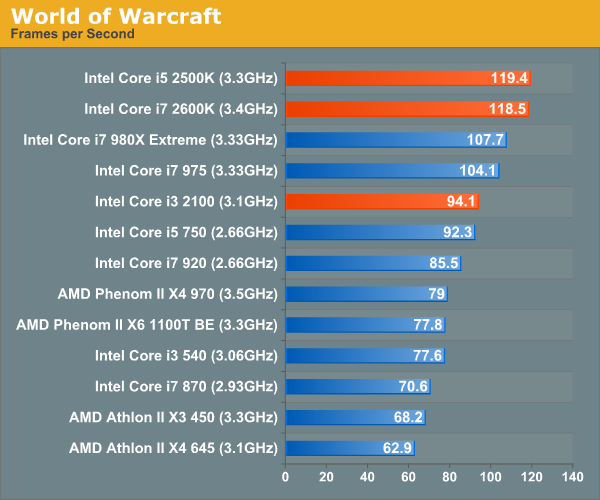
For Starcraft II we're using our heavy CPU test. This is a playback of a 3v3 match where all players gather in the middle of the map for one large, unit-heavy battle. While GPU plays a role here, we're mostly CPU bound. The Radeon HD 5870 is running at 1024 x 768 at medium quality settings to make this an even more pure CPU benchmark.
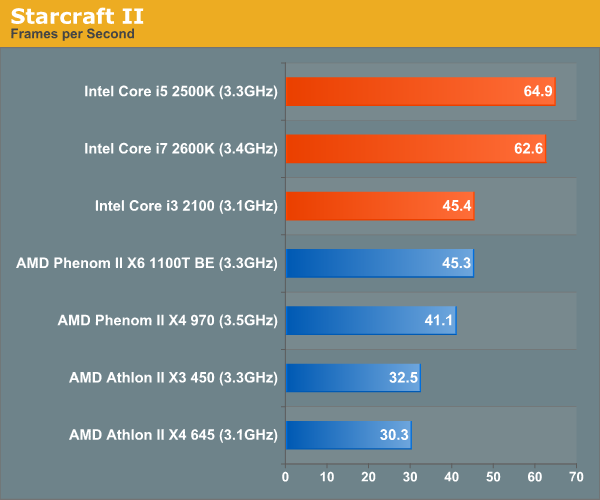
This is Civ V's built in Late GameView benchmark, the newest addition to our gaming test suite. The benchmark outputs three scores: a full render score, a no-shadow render score and a no-render score. We present the first and the last, acting as a GPU and CPU benchmark respectively.
We're running at 1680 x 1050 with all quality settings set to high. For this test we're using a brand new testbed with 8GB of memory and a GeForce GTX 580.
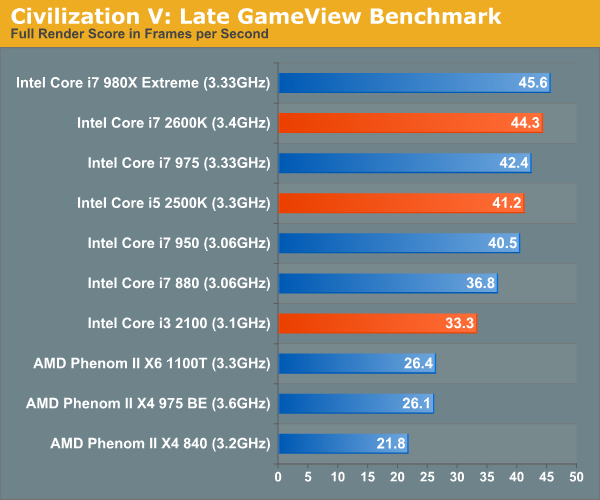
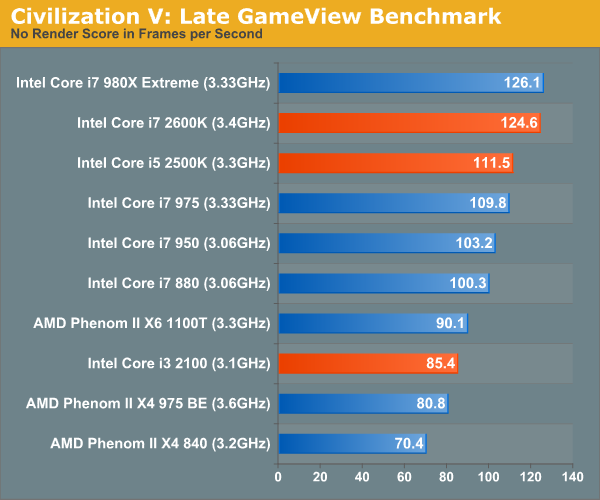










283 Comments
View All Comments
auhgnist - Monday, January 17, 2011 - link
For example, between i3-2100 and i7-2600?timminata - Wednesday, January 19, 2011 - link
I was wondering, does the integrated GPU provide any benefit if you're using it with a dedicated graphics card anyway (GTX470) or would it just be idle?James5mith - Friday, January 21, 2011 - link
Just thought I would comment with my experience. I am unable to get bluray playback, or even CableCard TV playback with the Intel integrated graphics on my new I5-2500K w/ Asus Motherboard. Why you ask? The same problem Intel has always had, it doesn't handle the EDID's correctly when there is a receiver in the path between it and the display.To be fair, I have an older Westinghouse Monitor, and an Onkyo TX-SR606. But the fact that all I had to do was reinstall my HD5450 (which I wanted to get rid of when I did the update to SandyBridge) and all my problems were gone kind of points to the fact that Intel still hasn't gotten it right when it comes to EDID's, HDCP handshakes, etc.
So sad too, because otherwise I love the upgraded platform for my HTPC. Just wish I didn't have to add-in the discrete graphics.
palenholik - Wednesday, January 26, 2011 - link
As i could understand from article, you have used just this one software for all these testings. And I understand why. Is it enough to conclude that CUDA causes bad or low picture quality.I am very interested and do researches over H.264 and x264 encoding and decoding performance, especially over GPU. I have tested Xilisoft Video Converter 6, that supports CUDA, and i didn't problems with low quality picture when using CUDA. I did these test on nVidia 8600 GT and for TV station that i work for. I was researching for solution to compress video for sending over internet with low or no quality loss.
So, could it be that Arcsoft Media Converter co-ops bad with CUDA technology?
And must notice here how well AMD Phenom II x6 performs well comparable to nVidia GTX 460. This means that one could buy MB with integrated graphics and AMD Phenom II x6 and have very good encoding performances in terms of speed and quality. Though, Intel is winner here no doubt, but jumping from sck. to sck. and total platform changing troubles me.
Nice and very useful article.
ellarpc - Wednesday, January 26, 2011 - link
I'm curious why bad company 2 gets left out of Anand's CPU benchmarks. It seems to be a CPU dependent game. When I play it all four cores are nearly maxed out while my GPU barely reaches 60% usage. Where most other games seem to be the opposite.Kidster3001 - Friday, January 28, 2011 - link
Nice article. It cleared up much about the new chips I had questions on.A suggestion. I have worked in the chip making business. Perhaps you could run an article on how bin-splits and features are affected by yields and defects. Many here seem to believe that all features work on all chips (but the company chooses to disable them) when that is not true. Some features, such as virtualization, are excluded from SKU's for a business reason. These are indeed disabled by the manufacturer inside certain chips (they usually use chips where that feature is defective anyway, but can disable other chips if the market is large enough to sell more). Other features, such as less cache or lower speeds are missing from some SKU's because those chips have a defect which causes that feature to not work or not to run as fast in those chips. Rather than throwing those chips away, companies can sell them at a cheaper price. i.e. Celeron -> 1/2 the cache in the chip doesn't work right so it's disabled.
It works both ways though. Some of the low end chips must come from better chips that have been down-binned, otherwise there wouldn't be enough low-end chips to go around.
katleo123 - Tuesday, February 1, 2011 - link
It is not expected to compete Core i7 processors to take its place.Sandy bridge uses fixed function processing to produce better graphics using the same power consumption as Core i series.
visit http://www.techreign.com/2010/12/intels-sandy-brid...
jmascarenhas - Friday, February 4, 2011 - link
Problem is we need to choose between using integrated GPU where we have to choose a H67 board or do some over clocking with a P67. I wonder why we have to make this option... this just means that if we dont do gaming and the 3000 is fine we have to go for the H67 and therefore cant OC the processor.....jmascarenhas - Monday, February 7, 2011 - link
and what about those who want to OC and dont need a dedicated Graphic board??? I understand Intel wanting to get money out of early adopters, but dont count on me.fackamato - Sunday, February 13, 2011 - link
Get the K version anyway? The internal GPU gets disabled when you use an external GPU AFAIK.